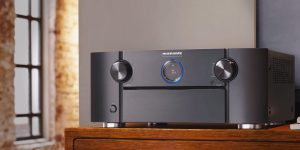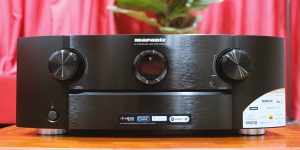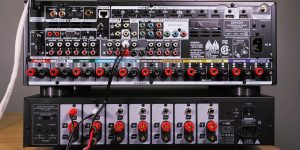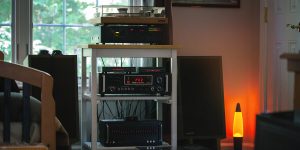Do you want to get more vivid emotions from movies, music, and games? Well, then you can’t do without a quality receiver. But unfortunately, choosing the right AVR you need is not a simple task. That’s why I have collected the best Denon receivers for you, which will allow you to reveal the sound potential of your system to the maximum.
The Japanese manufacturer Denon has been providing quality products since 1910 (including receivers). And during this time, the company has released a vast number of different models. However, the common user may find it challenging to make the right choice among so many options.
My task is to help you with this, as the choice of a suitable appliance depends on its features, your needs, capabilities, and room size. Well, let’s move on to the first option.

Denon AV receivers comparison table
| Name | Channels | Power output | HDMI in/out | Bluetooth/Wi-Fi | Review |
|---|---|---|---|---|---|
| Denon AVR-X3800H best overall | 9.4 | 105W/8 Ohm, 135W/6 Ohm | 6/3 | yes/yes | Review |
| Denon AVR-S570BT budget pick | 5.2 | 70W/8 Ohm, 90W/6 Ohm | 4/1 | yes/no | Review |
| Denon AVR-X6700H premium | 11.2 | 140W/8 Ohm, 175W/6 Ohm | 8/3 | yes/yes | Review |
| Denon AVR-X2700H mid-priced | 7.2 | 95W/8 Ohm, 125W/6 Ohm | 6/2 | yes/yes | Review |
| Denon AVR-S650H choice under $500 | 5.2 | 75W/8 Ohm, 100W/6 Ohm | 5/1 | yes/yes | Review |
| Denon DRA-800H stereo | 2.2 | 100W/8 Ohm, 120W/6 Ohm | 5/1 | yes/yes | Review |
Best Denon AV receiver reviews
Denon AVR-X3800H – best overall

I want to start my review with AVR-X3800H, which replaced X3700H and, in my opinion, is the best Denon receiver. And I’ll explain to you why.
It is a 9.4-channel AVR with 105 watts per channel (8 Ohms, 20 Hz – 20 kHz, THD: 0.08%). The power remains the same as the previous model, but it is more than enough for small and medium-sized rooms. But now you can connect not 2 but 4 subwoofers. This can significantly affect the overall sound picture. By the way, none of the other participants of my top has such an option.
Yes, this is an 8K receiver. 8K video is supported on all 6 HDMI (2.1) inputs and 2 of the 3 outputs. Of course, it supports HLG, HDR, Dolby Vision, HDR10+, and dynamic HDR. I didn’t mention 4K, but surely the receiver supports that resolution as well. When I tested this model, the picture looked rich and bright while watching movies. I was satisfied, and I’m sure you won’t be disappointed either. An added advantage is the presence of IMAX Enhanced. Thanks to this certification, you can have a memorable experience by watching IMAX content.
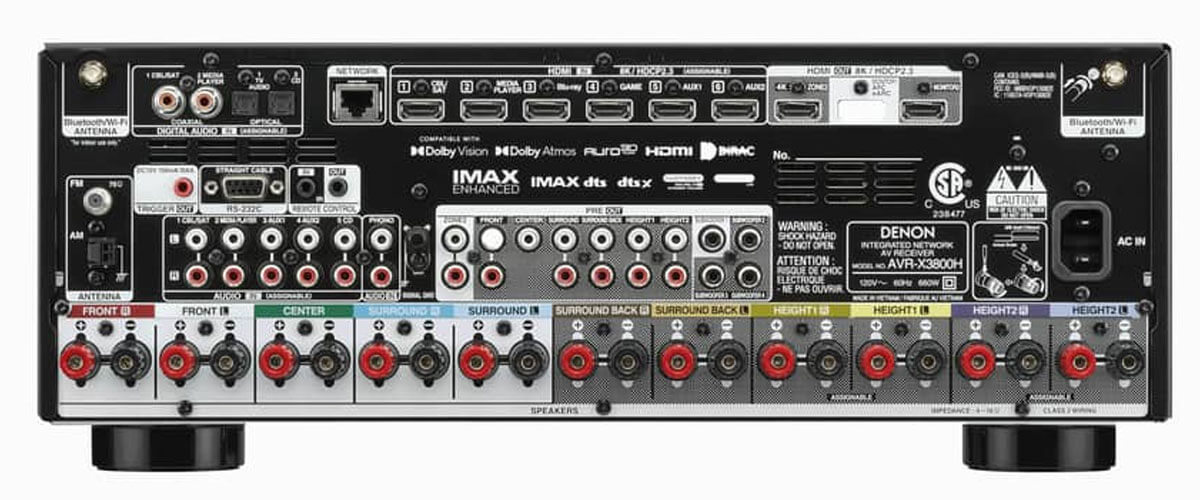
The device works well with Lossy formats (MP3, AAC, and WMA) and Lossless formats (FLAC HD, WAV, ALAC (all 192kHz/24 bit)). I would like to note the presence of Audyssey MultEQ XT32 technology, which allows you to correct any problems in the acoustics of your system. Well, in this model (unlike the previous one), there is already Dirac Live, which, in my opinion, is the optimal solution for the digital correction of room acoustics.
As with any high-end modern AVR-X3800H, the AVR-X3800H has advanced networking capabilities. Among the possible connections, you will find Ethernet, Wi-Fi, and Bluetooth ports. Of course, you will find AirPlay 2 support, as well as Spotify and Pandora.
But the main advantage of the Denon AVR-X3800H is the sound. The model has full 3D sound support: Dolby Atmos, DTS:X, IMAX Enhanced, Auro-3D, Dolby Surround and DTS Neural:X. I tested the sound with HEOS speakers, and everything worked great. The surround sound was very atmospheric and dynamic, with an emphasis on details.
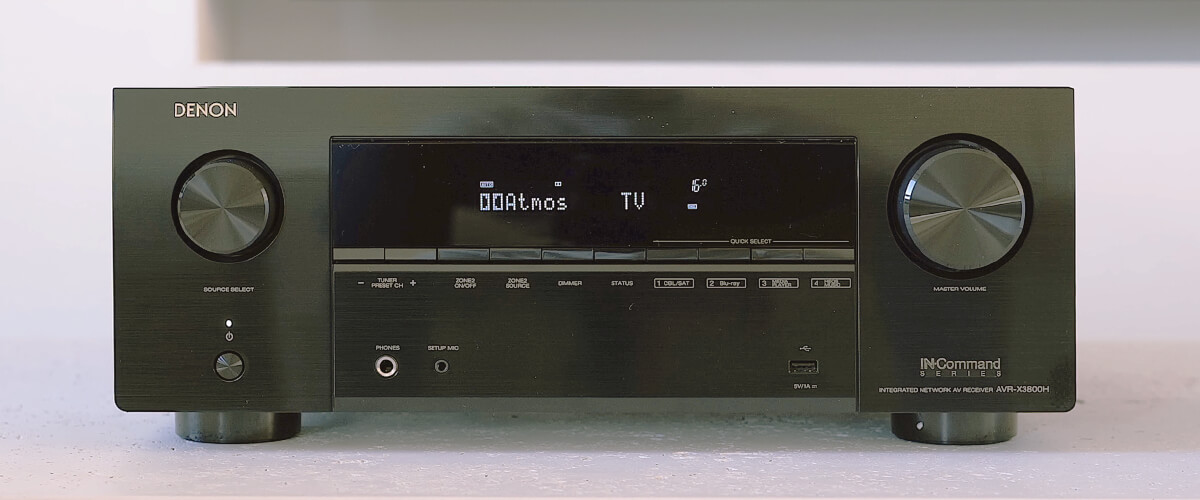
It can be controlled by remote, program, or voice, which is very convenient. So Apple Siri, Google Assistant, and Alexa are all at your disposal.
Next on my list, you will meet the premium model AVR-X6700H. If you compare it with X3800H, you will hardly find any significant differences. Yes, perhaps X6700H is a bit more powerful and has more channels, but these are not strategic advantages. So, in essence, they are equivalent, but the winner of my rating is a bit cheaper. But as always, the choice is yours.
I have the most wonderful impressions about AVR-X3800H. It really gave me a lot of pleasant moments when watching movies and listening to music. Besides, it is easy to set up and use. And all this is organically combined with its price. That is why it deservedly takes the first place in my rating.
Key specs
- Channels: 9.4.
- Power output: 105W/8 Ohm, 135W/6 Ohm.
- HDMI inputs/outputs:6/3.
- Video functions: 8K/60Hz, 4K/120Hz, 4K/60Hz.
- Bluetooth/Wi-Fi: yes/yes.
- Streaming services: Airplay 2, Pandora, Spotify, Napster, SiriusXM, TIDAL, Deezer, Qobuz, Amazon Music.
- Supports: HDMI Upscaling up to 8k, Dolby Vision.
- Surround sound: Dolby TrueHD, Dolby Digital Plus, DTS-HD Master Audio, Dolby Surround, DTS:X.
Pros
- Supports up to 4 subwoofers.
- Dirac Live/Audyssey MultEQ XT32.
- 8K support.
- Voice control.
- Advanced networking capabilities.
- Support for all modern surround sound formats.
Cons
- Not a very convenient remote control.
- Quite complicated manual.
- Limited support for outdated video.
Denon AVR-S570BT – budget pick
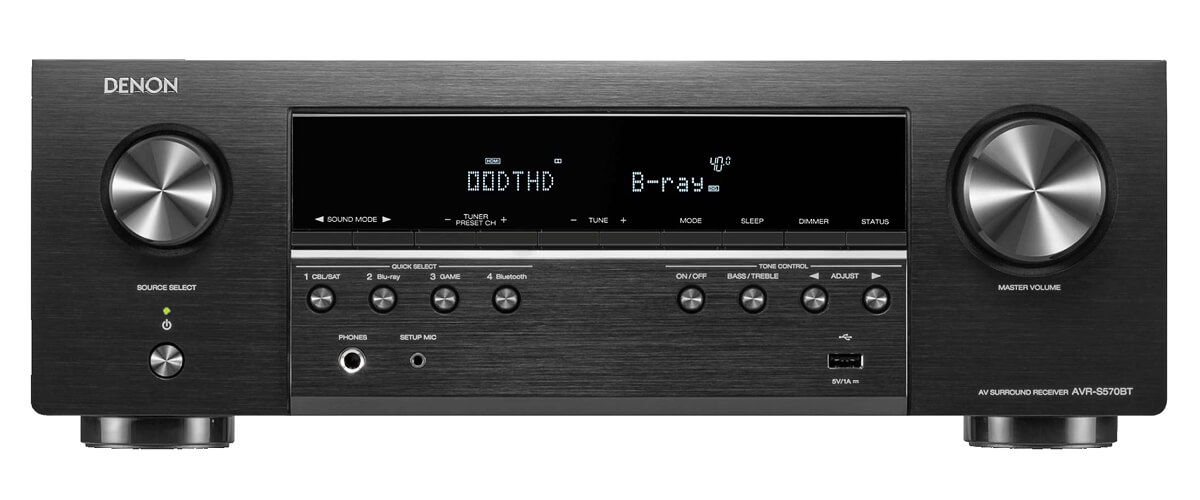
The next device on my list is the Denon AVR-S570BT. This receiver doesn’t have advanced features, but it’s quite suitable for unassuming users who are only interested in basic features. It was released in 2022 to replace the AVR-S570BT. The new model offers users a 5.2-channel amplifier with a power of about 70 watts per channel (8 Ohms, 20 Hz – 20 kHz, total harmonic distortion: 0.08%). By the way, it does not differ from its predecessor in these parameters.
This budget Denon AVR doesn’t have DSD Audio Capability and Audyssey MultEQ XT and does not support Lossy/Lossless Formats. Unfortunately, this is something you have to put up with. Accordingly, you need to be prepared to deal with several problems that will arise when calibrating the sound of your room and reading specific formats.
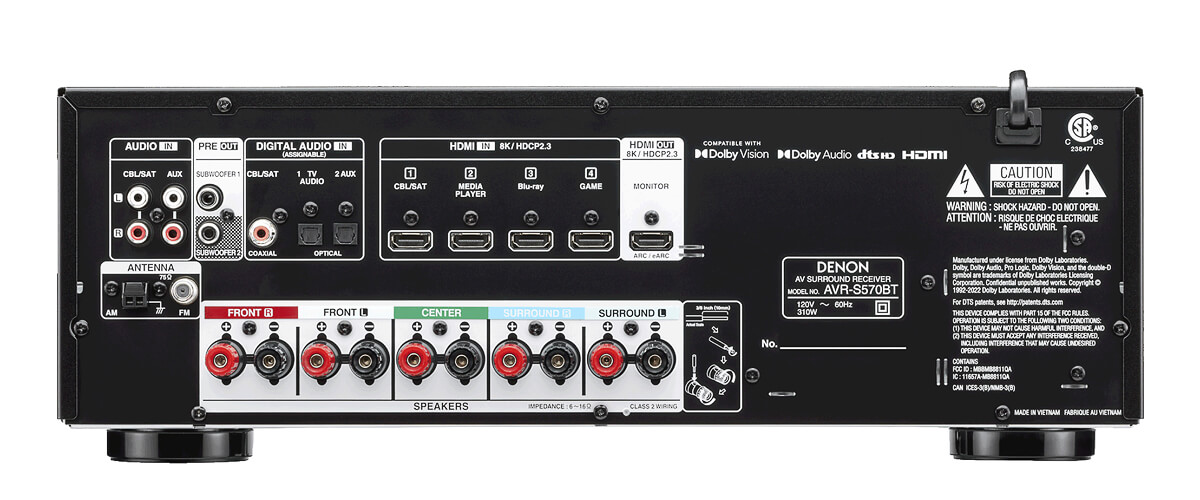
As for the video capabilities, due to the HDMI 2.1 standard, it has seriously overtaken AVR-S540BT and can work not only with 4K resolution but also with 8K. In addition, it supports HDR, HLG, Dolby Vision, HDR10+, and Dynamic HDR. Fans of gaming consoles will be happy with the presence of VRR and QFT. As you can see in this aspect, everything is quite good for a budget model.
Now, let’s move on to the connectors and connection methods. The Denon AVR-S570BT offers its users 4 HDMI inputs (2.1) and 1 HDMI output with HDCP 2.3 processing. There are only 2 options among the connections – subwoofer outputs and Bluetooth. Unfortunately, the Wi-Fi and Ethernet ports are not available in this model.
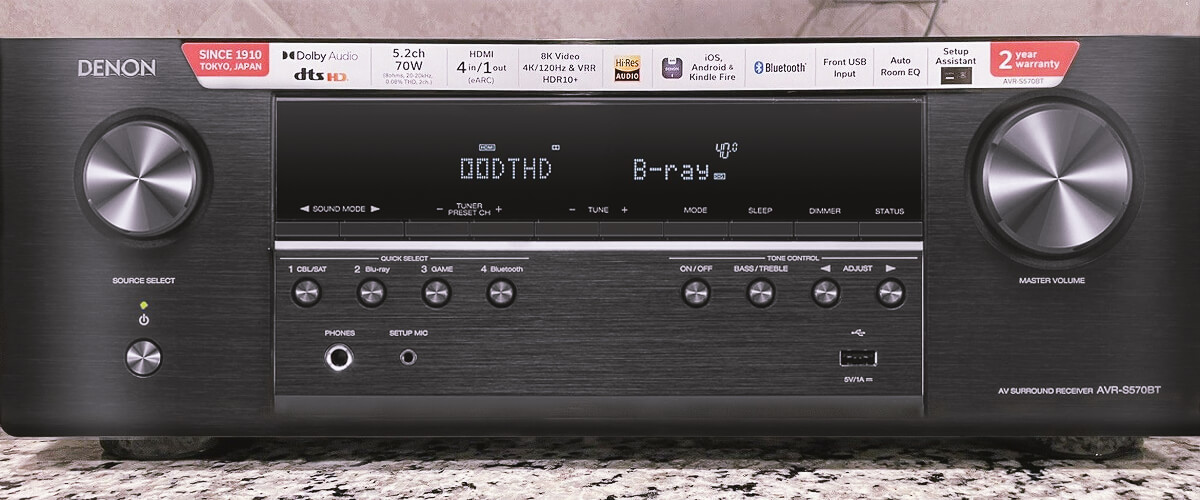
You shouldn’t have any problems with setting it up. At the very least, thanks to the Denon Setup Assistant, I quickly did everything I needed.
Well, what about the sound? First of all, it supports DTS HD Master and Dolby TrueHD. And secondly, the sound is pretty good for its money. It’s a bit husky at maximum volume. But any distortion is absent if you listen to music at levels around 40-60%.
I would say that the Denon AVR-S570BT is the most suitable receiver for listening to music and watching movies at an amateur level. Of course, this model can’t boast of anything special. But the 5.2 channel amplifier and 4K/8К resolution support are enough for most of your needs. And if you consider the cost of the AVR, in this case, you don’t have much to lose.
Key specs
- Channels: 5.2.
- Power output: 70W/8 Ohm, 90W/6 Ohm.
- HDMI inputs/outputs: 4/1.
- Video functions: 4K/120Hz, 8K/60Hz pass-through, upscaling to 8K.
- Bluetooth/Wi-Fi: yes/no.
- Streaming services: no.
- Supports: HDMI ARC, HDMI eARC, HDMI CEC, HDCP2.3, HLG, HDR10, HDR10+, Dolby Vision.
- Surround sound: Dolby TrueHD, DTS-HD Master Audio.
Pros
- Presence of DTS HD Master and Dolby TrueHD.
- 8K support.
- The AVR is easy to set up with the Denon Setup Assistant.
Cons
- Wi-Fi and Ethernet ports are not available.
- No DSD Audio Capability and Audyssey MultEQ XT.
- No multi-room.
- Does not support Lossy Formats/Lossless Formats.
Denon AVR-X6700H – premium
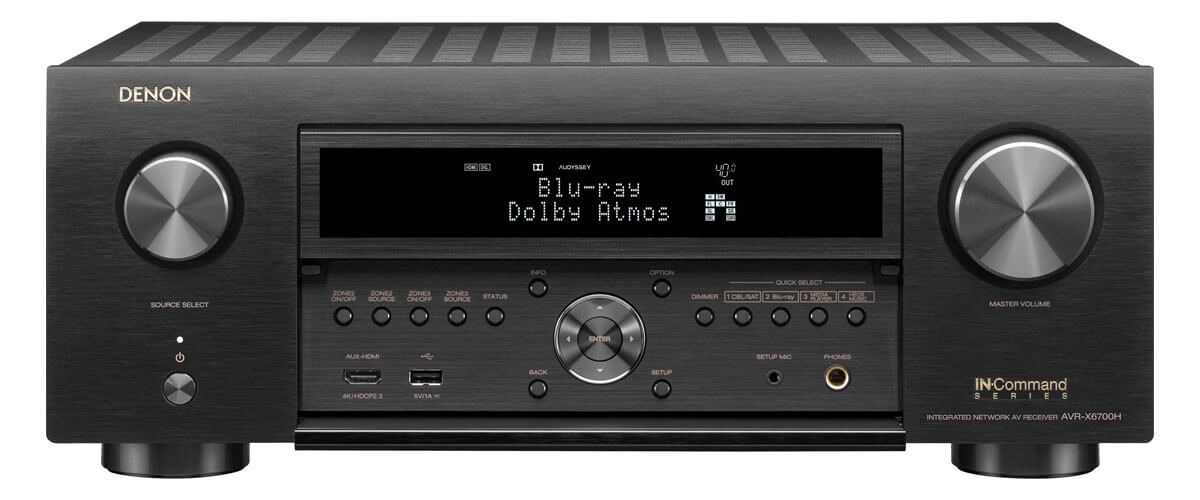
Well, here we come to the premium Denon AV receiver. Such a monster can satisfy all your wishes regarding sound, video, and more. Now, I will explain all its functions in more detail.
Firstly, there is an 11.2 channel amplifier with 140 W per channel (8 Ohms, 20Hz-20kHz, THD: 0.05%, 2 ch. driven). In addition, the Denon AVR-X6700H has as many as three multi-room zones. This allows you to enjoy quality music covering a large area of your home and controlling the sound via the app.
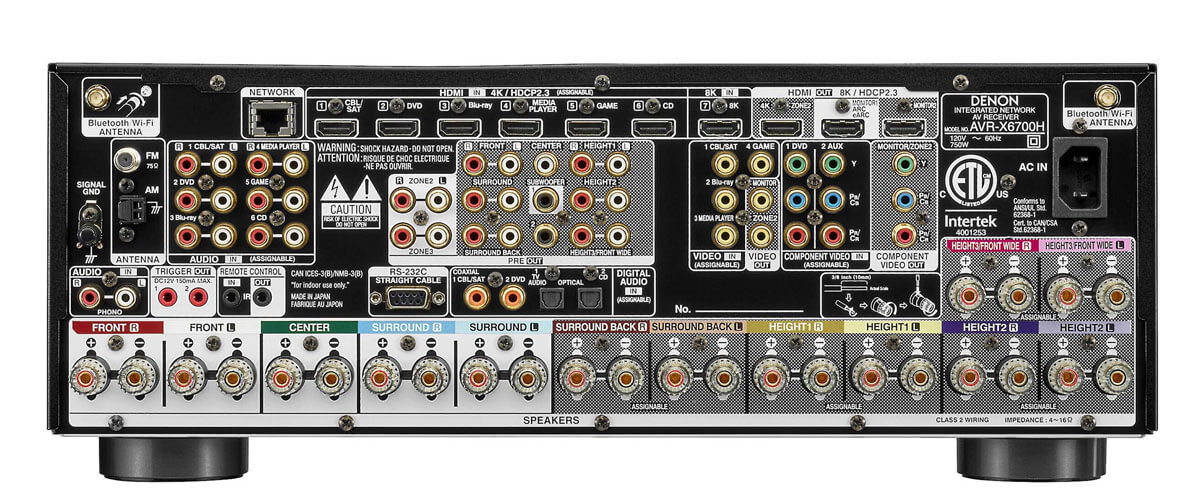
Secondly, the quality of the picture is at the highest level. If you buy this model, you will get 8K resolution at 60Hz and 4K resolution at 120Hz. There is also IMAX Enhanced support, as it should be. In other words, positive emotions from watching your favorite content are guaranteed.
As for connectors, in this model, you can find 7 HDMI inputs (2.1/eARC) on the back panel and 1 HDMI on the front side of the receiver. There are 3 outputs with HDCP 2.3 support. The available connections are 2 subwoofer outputs (independent), WiFi, Bluetooth, and Ethernet Ports. Of course, there is also VRR, ALLM, Dynamic HDR, and HDR10+ support.

The sound is incredible because the Denon AVR-X6700H has the latest 3D audio (Dolby Atmos Height Virtualization technology, DTS:X Pro, DTS Virtual:X, Auro-3D, and IMAX Enhanced) in its arsenal. This receiver perfectly processes and decodes most formats as well as supports Lossless formats and Lossy formats. To all this, the AVR is easy to calibrate thanks to Audyssey MultEQ XT32 technology. While the sound is very clear and dynamic, some users complain about a bug with the sound when the receiver shuts down for a moment and then continues to work again. However, I did not face such a problem when testing the model.
Although the AVR costs quite a lot, its price is justified. It is the best Denon AV receiver which, in addition to excellent picture and clear sound, boasts the latest DTS:X Pro, Auro-3D technology, as well as 3 multi-room zones.
Key specs
- Channels: 11.2.
- Power output: 140W/8 Ohm, 175W/6 Ohm.
- HDMI inputs/outputs: 8/3.
- Video functions: 8K/60Hz, 4K/120Hz, 4K/60Hz.
- Bluetooth/Wi-Fi: yes/yes.
- Streaming services: Airplay 2, Pandora, Spotify, Napster, SiriusXM, TIDAL, Deezer, Qobuz, Amazon Music.
- Supports: HDMI Upscaling up to 8k, Dolby Vision, Auro 3D.
- Surround sound: Dolby TrueHD, Dolby Digital Plus, DTS-HD Master Audio, Dolby Surround, DTS:X, DTS Neural:X.
Pros
- Powerful 11.2-channel amp.
- The latest 3D audio is available.
- Advanced 8K video.
- Plenty of HDMI (2.1).
- Game-oriented AVR.
- 3 multi-room zones.
Cons
- No minuses.
Denon AVR-X2700H – best mid-priced
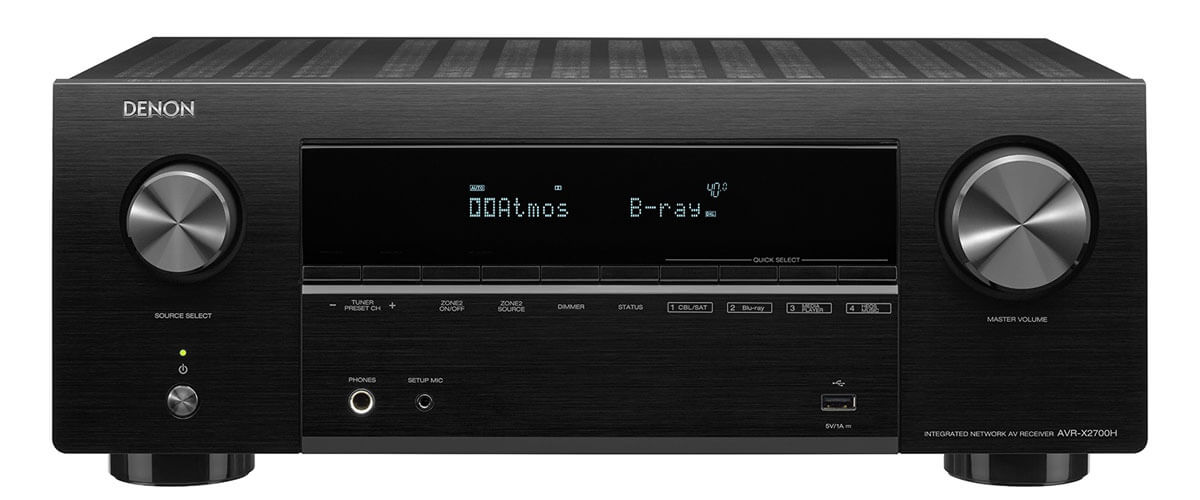
I think many people would like this solution. The Denon AVR-X2700H (2020) is the fourth model on my list. And it is in the group of the finest mid-priced receivers. Why? Stay with me, and you will find out.
Starting off, the AVR has a 7.2 channel amplifier with about 95 W per channel (8 ohms, 20Hz – 20kHz, THD: 0.08%). As in other good models, the receiver has multi-room zones. In this case, there are two units.
The picture looks good, quite detailed, and even alive. This is not surprising since the AVR-X2700H supports 8K Ultra HD (60Hz) and 4K (120Hz). So it’s nice to look at the screen while watching a movie.
I also want to mention that the model supports many audio file formats, including Lossy formats and Lossless formats. You can automatically calibrate the device easily, quickly, and accurately using Audyssey MultEQ XT technology.

The Denon AVR-X2700H has 6 HDMI inputs (only 1 HDMI 2.1/eARC) and 2 HDMI outputs with HDCP 2.3 support on the back panel. Available connections to the receiver include 2 subwoofer outputs, Bluetooth, Ethernet Ports, and Wi-Fi. And, of course, technologies such as ALLM, Dynamic HDR, and HDR10+ improve the overall quality of watching content.
As for the sound, the music is pretty atmospheric and voluminous. I would classify this model as a surround sound receiver because the AVR-X2700H has full 3D audio support. Even though it does not have DTS:X Pro and Auro 3D features like the AVR-X6700H, there are Dolby Atmos, DTS:X, Dolby TrueHD, Dolby Atmos Height Virtualization, Dolby Surround, DTS Neural:X, and DTS HD Master. Agree that such a set for the middle class looks perfect.
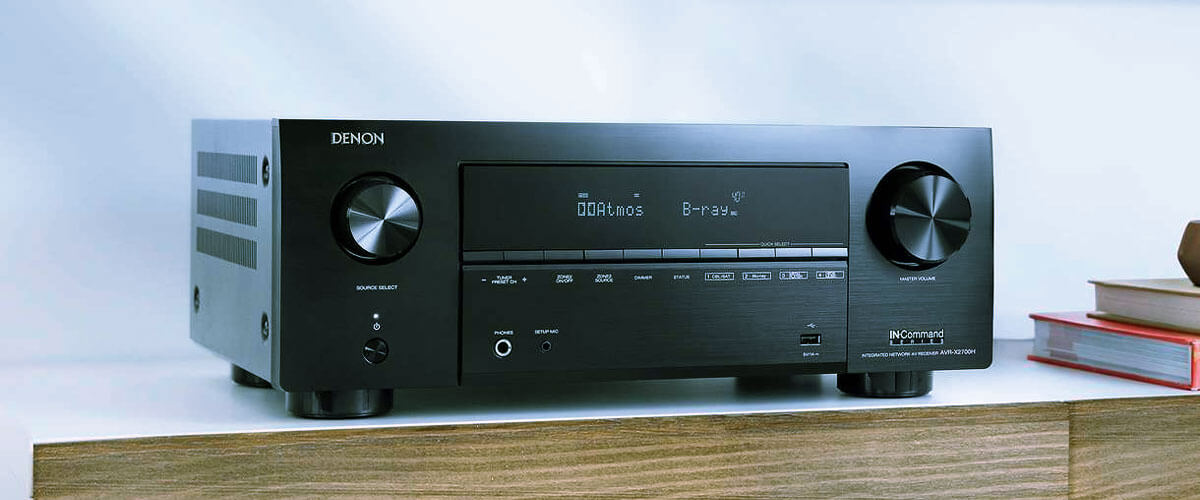
Moreover, you can control the device via voice, RS232, Web, App, and IP. This allows you to be more flexible, which certainly increases the comfort of using the model.
If you compare it to the X3700H, it will be cheaper; both support 8K, many formats, and the same number of multi-room zones. However, other indicators of the AVR-X2700H are weaker than the rival’s.
Overall, the model combines a normal price with a fairly wide range of functions and good features for its class.
Key specs
- Channels: 7.2.
- Power output: 95W/8 Ohm, 125W/6 Ohm.
- HDMI inputs/outputs: 6/2.
- Video functions: 8K/60Hz, 4K/120Hz, 4K/60Hz.
- Bluetooth/Wi-Fi: yes/yes.
- Streaming services: Airplay 2, Pandora, Spotify, Napster, SiriusXM, TIDAL, Deezer, Qobuz, Amazon Music.
- Supports: HDMI Upscaling up to 8k, Dolby Vision.
- Surround sound: Dolby TrueHD, Dolby Digital Plus, DTS-HD Master Audio, Dolby Surround, DTS Neural:X.
Pros
- Full 3D sound is available.
- Comfortable voice control.
- Progressive 8K Ultra HD resolution.
- 2 multi-room zones.
Cons
- 1 HDMI input (2.1).
Denon AVR-S650H – choise under $500
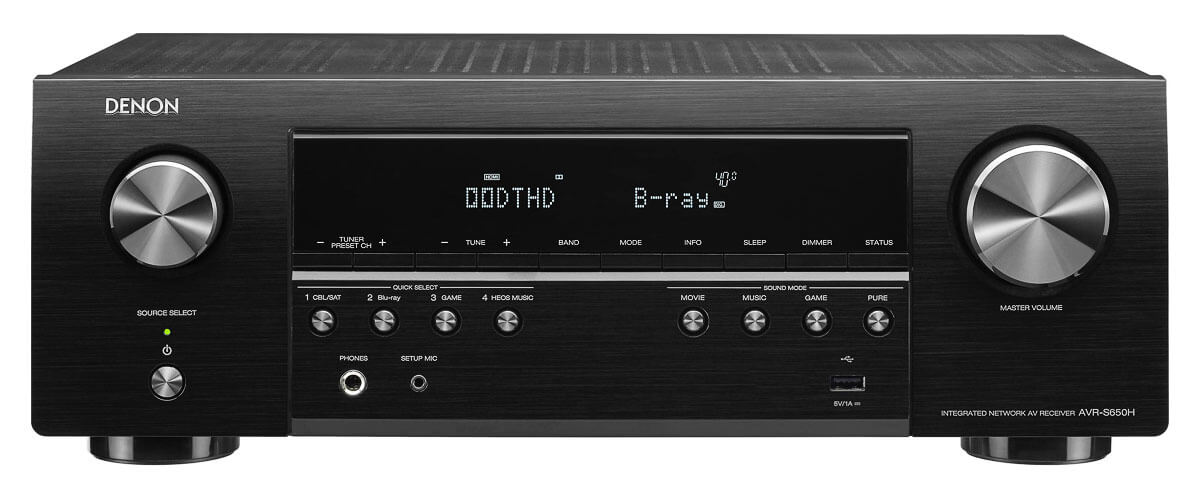
The Denon AVR-S650H (2019) is the penultimate model in my article. This receiver is suitable for those looking for a good product in price categories up to $500.
First, it is a 5.2 channel AVR with 75W per channel (8 ohms, 20Hz – 20kHz). There is no support for multi-room zones, but here, you can find the HEOS wireless multi-room technology. It is controlled through a special HEOS app.
For such a modest sum, you get 4K UHD HDMI/60Hz signal transmission with eARC support. Although it is a budget solution, the quality was satisfactory to me. The picture looks bright and beautiful.
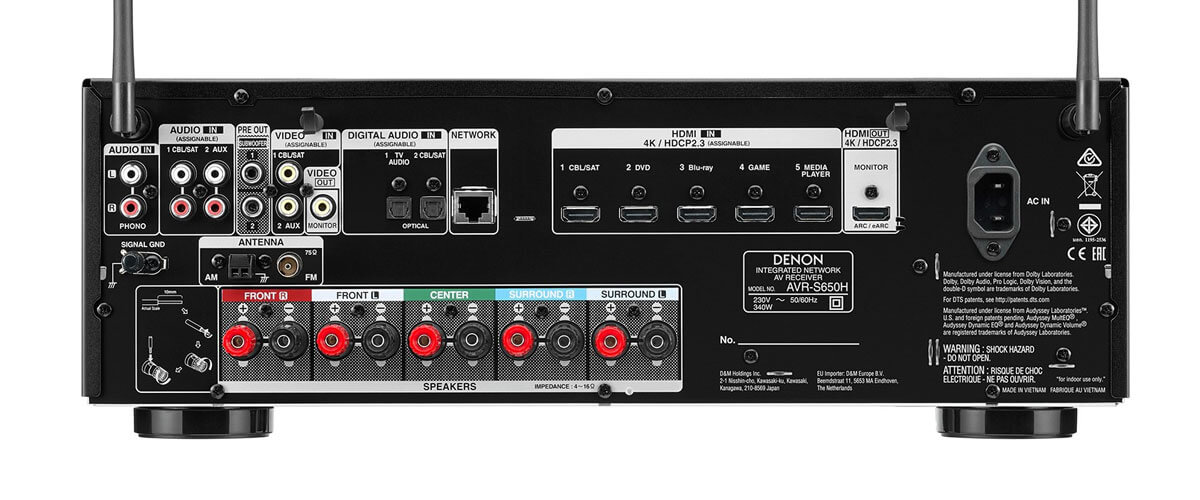
The AV receiver supports many formats, including Lossy and Lossless. The Audyssey MultEQ, Audyssey Dynamic Volume, and Audyssey Dynamic EQ help you set up the sound. The sound capabilities are significantly reduced compared to the more expensive variants. Only DTS HD Master and Dolby True HD are available. However, it doesn’t sound bad.
This model has HDMI (5 inputs/1 output) with HDCP 2.2 support. The available connections include 2 analog subwoofers outputs, Wi-Fi, Bluetooth, and Ethernet Ports. There are technologies such as HDR10, HLG, Dolby Vision and ALLM.
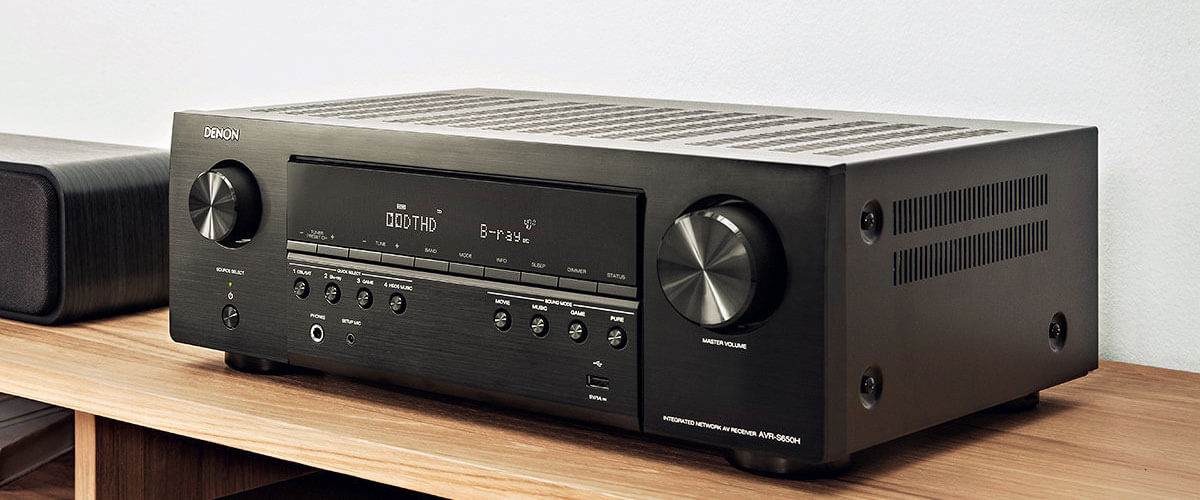
Compared to the Denon AVR-S540BT, this model has Audyssey MultiEQ, Wi-Fi, and Ethernet Ports. In addition, the receiver is made to the latest HDMI 2.1 specifications and supports Lossy and Lossless formats.
The AV receiver offers quite a lot of features for a small amount of money. Therefore, this model is an excellent solution for people who are not demanding at all and do not have a large budget. In addition to the mentioned features, sound and picture are on a decent level.
Key specs
- Channels: 5.2.
- Power output: 75W/8 Ohm, 100W/6 Ohm.
- HDMI inputs/outputs: 5/1.
- Video functions: 4K/60Hz.
- Bluetooth/Wi-Fi: yes/yes.
- Streaming services: Airplay 2, Pandora, Spotify, Napster, SiriusXM, TIDAL, Deezer, Qobuz, Amazon Music.
- Supports: HDR, HLG, Dolby Vision.
- Surround sound: Dolby TrueHD, DTS-HD Master Audio.
Pros
- Audyssey suite of EQ software.
- Availability of HEOS wireless multi-room technology.
- Voice assistant.
- Easy set up via Denon Setup Assistant.
Cons
- Limited sound capabilities.
- Only one HDMI output.
Denon DRA-800H – stereo
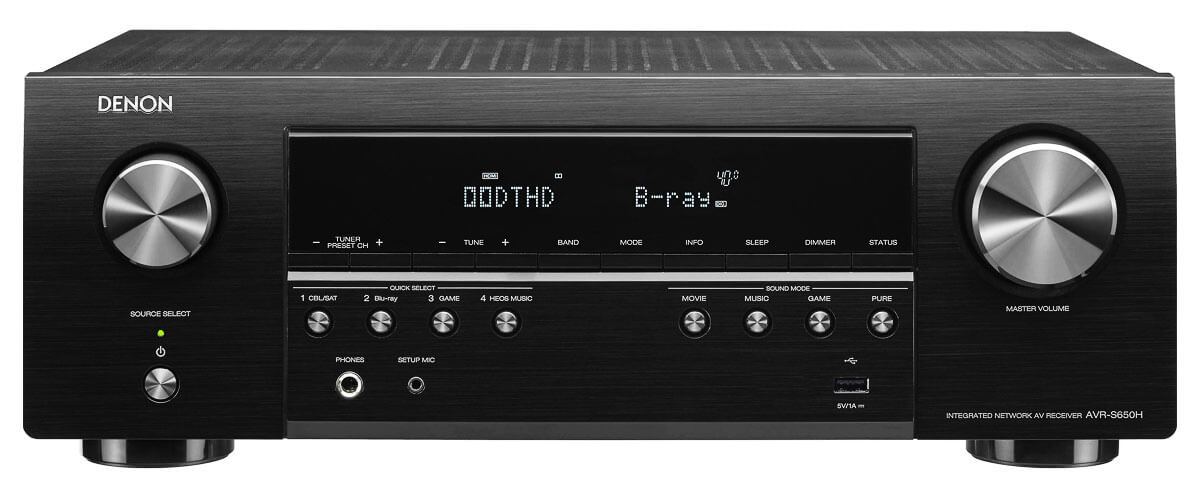
Finally, we come to the last sixth model, the Denon DRA-800H. I hope that you have already formed some idea of what you need. But I must also remind you about this receiver, which is more music-oriented.
In the Denon DRA-800H stereo receiver, you can find a 2.2 channel power amplifier with 100W per channel (8 ohms, 20Hz – 20kHz). As a result, it can work with a low impedance drive while providing high performance.
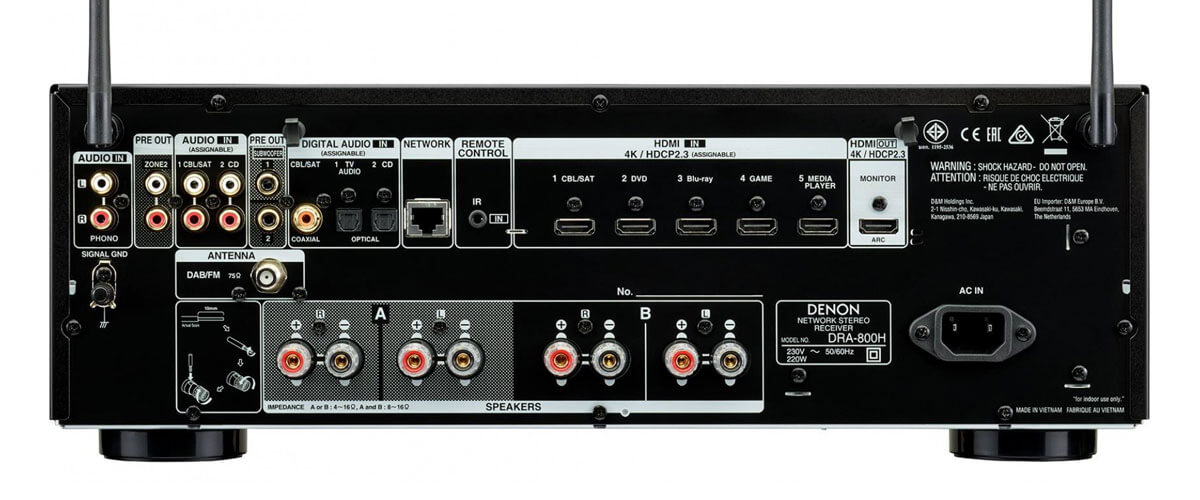
The DRA-800H has a 4K Ultra HD resolution (60Hz). There is nothing special in the picture – it looks pretty standard, but I want to draw your attention to the presence of two multi-room zones. There is support for Lossless and Lossy formats, but there is no sound calibration via Audyssey.
There are 5 HDMI inputs (2.0/ARC) and only 1 HDMI (2.0) output with HDCP 2.3 support on the back panel. Available connections include 2 subwoofer outputs, Bluetooth, Ethernet Ports, and WiFi. The HDR10, 4:4:4 color resolution, HLG, and BT.2020 are also present in this model.
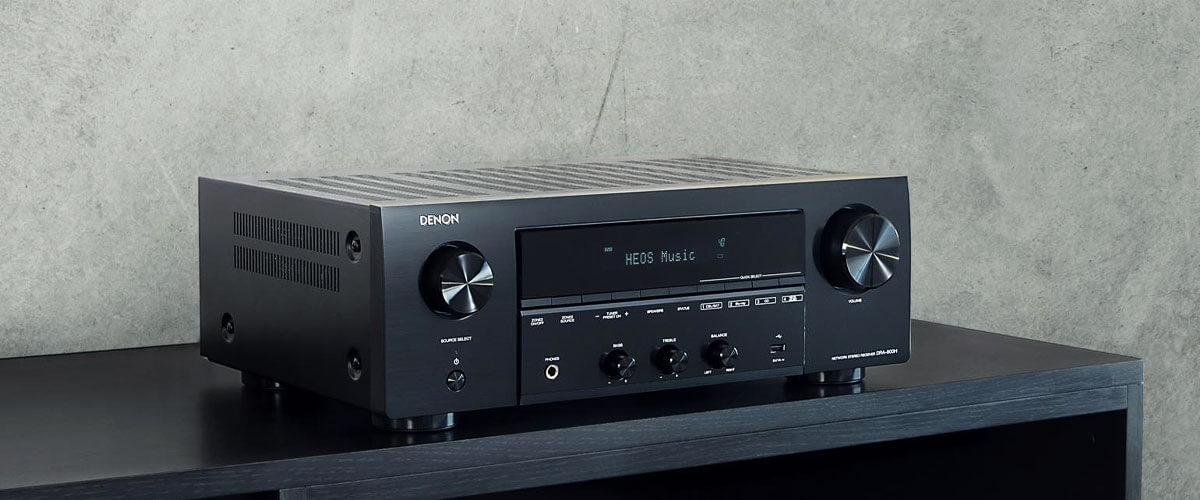
As for the sound, there are absolutely no features that support surround sound, but thanks to the 2-channel stereo amplifier, the receiver allows you to enjoy the Hi-Fi quality sound. That way, you get a detailed and accurate sound scene.
The DRA-800H gives you quality sound when listening to analog and digital sources.Also, a good advantage of the receiver is the presence of two multi-room zones and high-res audio support. In my opinion, this model is more suitable for avid music lovers.
Key specs
- Channels: 2.2.
- Power output: 100W/8 Ohm, 120W/6 Ohm.
- HDMI inputs/outputs: 5/1.
- Video functions: 4K/60Hz.
- Bluetooth/Wi-Fi: yes/yes.
- Streaming services: Airplay 2, Pandora, Spotify, Napster, SiriusXM, TIDAL, Deezer, Qobuz, Amazon Music.
- Supports: HDR, HLG.
Pros
- Voice control.
- Maximum focus on sound quality.
- High-resolution audio support.
- 2 multi-room zones.
Cons
- Surround sound is not provided.
- One HDMI output.
- All HDMI version 2.0.
Denon receivers buying guide
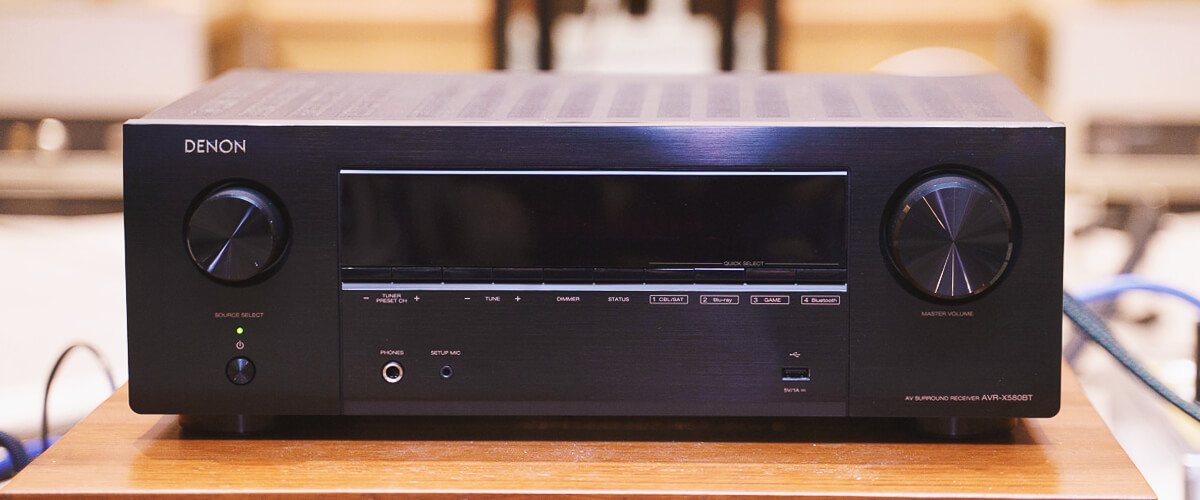
Choose the number of channels and amplification power you need
You should understand that the power of the amplifier and the number of channels directly affect the final price of the receiver. That is why choosing a suitable device for yourself is essential, so that you won’t overpay for features you don’t need. For example, if you want to listen to quality surround sound in small rooms, I recommend choosing a 5.2 channel receiver. That will be quite enough. However, for large rooms, the 7.2 channel device is better suited. The logic here is simple – the more channels the AVR has, the better surround sound you get.
Also, I suggest you choose an amplifier with some excess power. Because if you are listening to music at a high volume, it can cause a lot of distortion. Personally, I like having 100 W per channel or more for larger areas.
Pay attention to the connections you need
There is a widespread misconception that there may be too many inputs/outputs. But in my experience, I can confidently say that you will quickly find a use for them after a while.
I advise you to choose a receiver with many HDMI Inputs/Outputs version 2.1. The fact that this solution has a larger bandwidth, which allows you to get a better picture and sound. It is not superfluous to have 1-2 additional inputs. Additionally, eARC (Enhanced Audio Return Channel) support is very important. Due to its high capacity, this feature has become widespread, almost completely replacing ARC.
You should also pay attention to the support of connection via Wi-Fi. I believe that this feature should be present in every modern receiver.
Multi-room and streaming music services
The number of multi-room zones also vastly affects the final price of the device. So before you buy, you must determine for yourself the need for such a function. For example, the Denon AVR-X6700H multi-zone receiver has three multi-room zones and is much more expensive than the Denon DRA-800H which is not equipped with this feature.
This feature serves to increase the comfort of using your home theater in different rooms. In other words, it allows you to transmit several audio streams at once. That way, you can listen to music in the sitting room while your children are watching a cartoon in the bedroom.
As for streaming music services, the modern models mainly support Tidal, Spotify, Apple Music, Deezer, and more. But it’s worth checking on the manufacturer’s official website.
Surround sound formats capability
Technologies such as DTS:X and Dolby Atmos are designed to allow you to enjoy surround sound, making the sound more dynamic and exciting. Which one you choose is up to you. But modern receivers often support both technologies.
And such new formats of surround sound as Auro 3D and DTS:X Pro are not available in every model. This is a brand new level of sound that has amazing accuracy and detalization.
Support for surround sound formats is generally present only in the more expensive models. So, if you want to build a quality home theater with 3D sound, you must pay for it.
It is also worth mentioning that you need a receiver with a 7-channel amplifier for better surround sound. In this case, connecting two additional rear speakers is possible, which is not done in a 5-channel receiver.

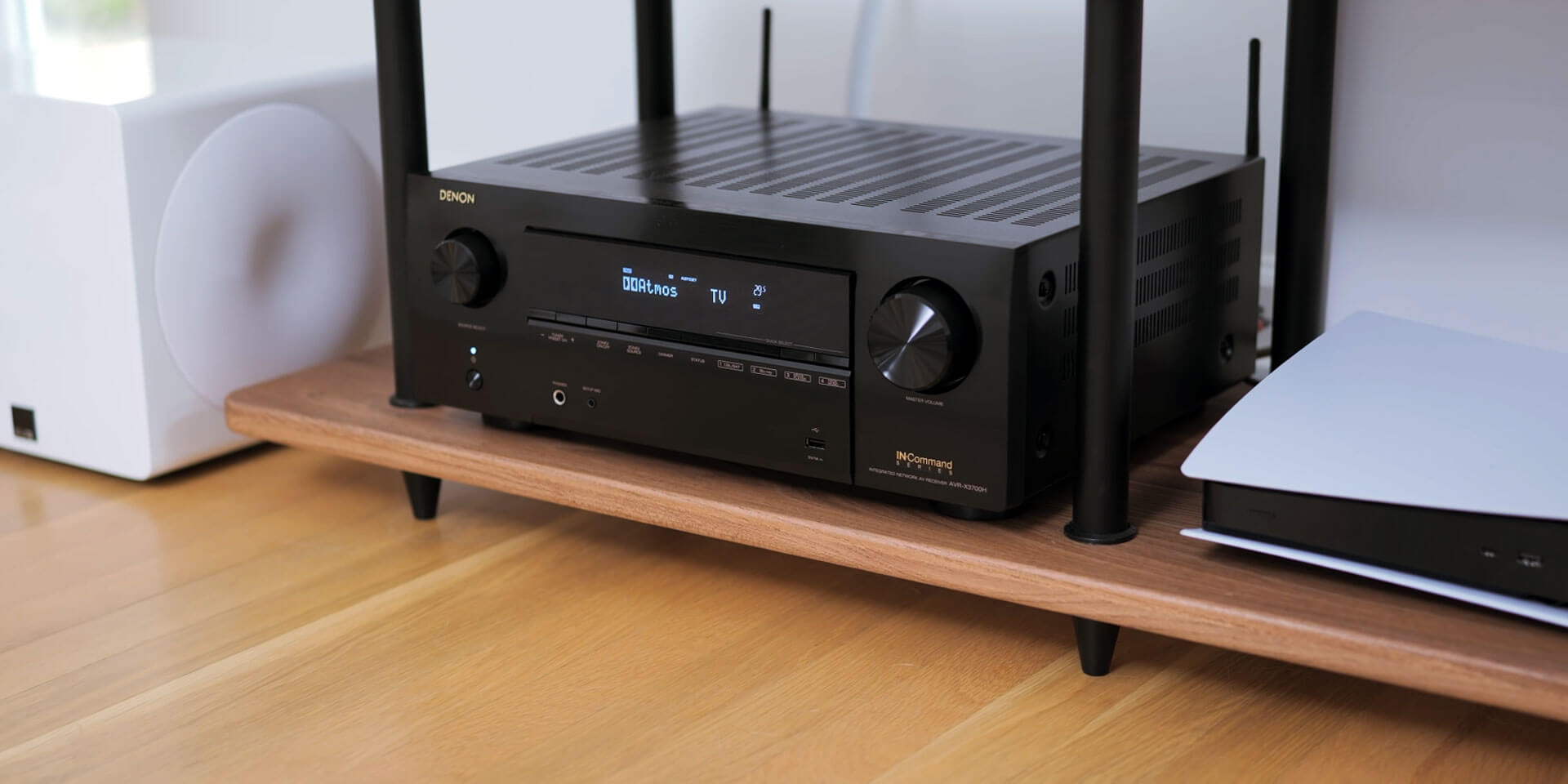


![Best 2-Channel Receiver [Expert Reviews and Buying Guide]](https://hometheaterology.com/wp-content/uploads/2023/11/best-2-channel-receiver-stereo-300x150.jpg)


